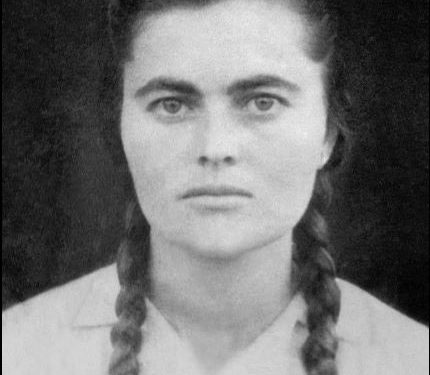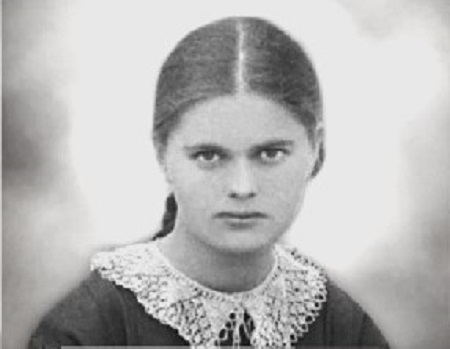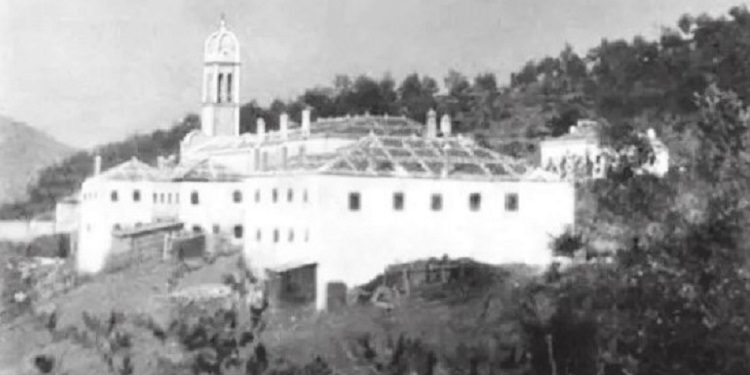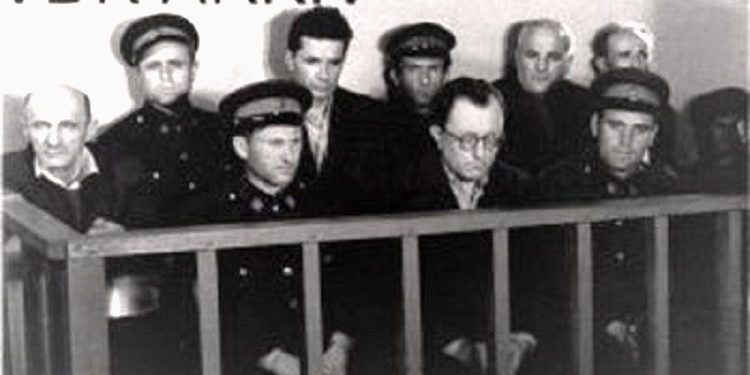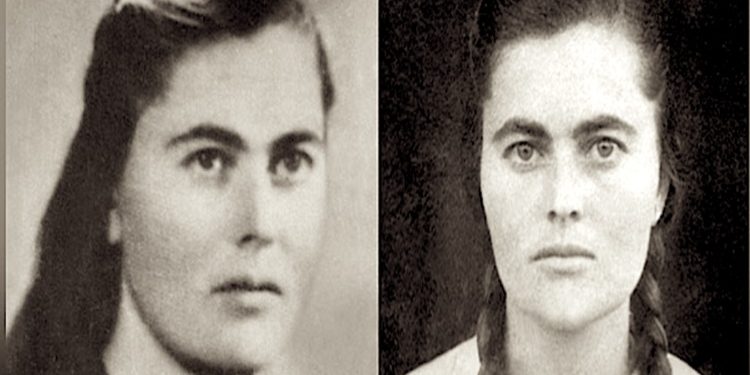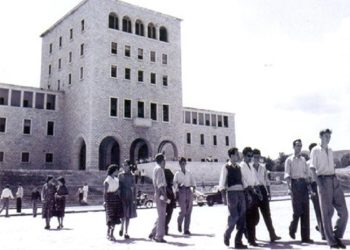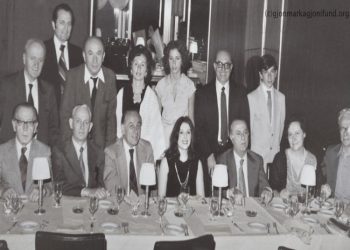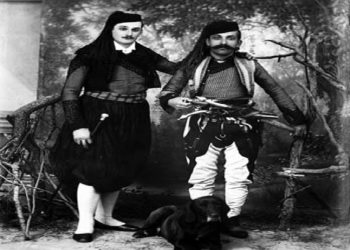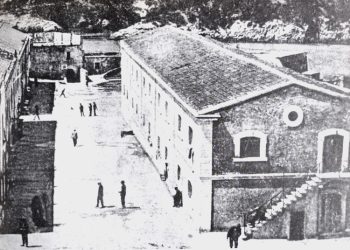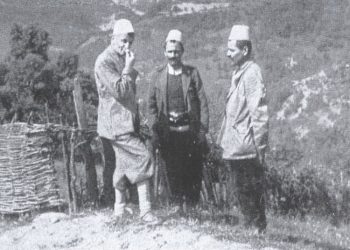By Ndue Dedaj
Memorie.al / Marie Tuci, the only woman among the 38 martyrs of the Catholic Church in Albania, was young enough to have a biography with many words, but she was creating it day by day, if they would not cut down her tree of life just when it had begun to bloom. We try to imagine her childhood, in Mirdita, certainly like that of all her peers, until a light shone in her brain and an exalting spark ignited. She was born in Nëdërfushaz, on the edge of Fani i Vogël, on March 12, 1928, in the aforementioned tower of Mark Tuci, of Dera e Gjomarkajve, the trunk of Preng Bib Doda, Prince of Mirdita, one of the important Albanian political figures with a tragic end. No matter how much time passes, a person’s childhood and youth always “whisper” in the footsteps and first steps he takes in life, without knowing what his destiny will be…
THE FAMILY, FROM THE HOLY MOUNTAIN TO “THE LOWER OROSH”
Three centuries ago, like many other Orosh families, Marie’s ancestors had descended from the mountains of Orosh to the low plain area, bordering Rrëshen, stretching from Nëdërfushazi and Qafë – Molla to Bukmirë, Livadhëz, Qurkëz and Shpërdhazë, which were called “The Lower Orosh”. On the northern side, where this Orosh area met Kaçinar, a not very high hill would be called “Maja e Llesh të Zi”. It is no coincidence that on the other side of the Small Fan, the legendary captain Lleshi i Zi, had built an irrigation canal, the “Vijën e Madhe”, which in Mirdita would be the second architectural water work, after the ancient Domgjon Aqueduct.
This was the compensation of the townspeople who came down from the Holy Mountain for the local inter-Fanors, who had given them a share in their miran. During the years of the Albanian League of Prizren, Captain Marka Tuci of the Inter-Fushazit is mentioned as one of the main figures of Mirdita at that time, who in 1880, participated in the war to protect Plavë, Gucië, Hoti and Gruda, from Montenegrin attacks. His portrait, like that of other Mirdita warriors, appears in a photo of the “Marubi” of that time. Marie Tuci’s father, Nikollë Mark Tuci, and her brother Zef Mark Tuci, were the sons of Kapidan Mark Tuci.
When Marie Tuci was born, Mirdita, as is evident from the writings and monographs of authors Zef Mark Harapi, Dom Nikollë Kimza, Dom Prend Suli, Stavri Frashëri, etc., had not yet emerged from the “isolation” of centuries, lacking infrastructure, such as roads, telephony, electricity, etc. Schools were certainly few. Health care was negligible in relation to the needs of the inhabitants. Agriculture was limited to the crops it planted, such as corn, beans, etc. Trade was on a low scale, with a few shops of merchants from Shkodra and Kruta. The copper industry had just started with Italian entrepreneurs. Consequently, living conditions were poor. The region, one of the most famous in the Albanian world, was proud of its history of resistance to invaders over the centuries, while its epic of resistance would continue throughout the 20th century, embodied in unique figures such as that of Blessed Marie Tuci.
The cradle that rocked her childhood was a tower, a meadow and an oak forest between Fani i Madh and Fani i Vogël. In the land where she was born, there are so few memories, because the elderly are no longer alive. There were three children of a mother, a brother and two sisters, who would be swallowed up by the ideological revolution, the class struggle, the half-century of persecution. Somewhere, mistakenly, it is written that there were four of them.
TWO PINE TREES IN NDĖRFUSHAZ, PLANTED BY MARIE TUCI AND HER SISTER LIZA
To make our story about Marie Tuci more tangible, we have come to her birthplace in Nerfushas. We are together with Bardhok Filopati, nephew of Gjomarkajsh, whose mother Tereza, had told us years ago, events from the life of the “Sarajev” of Kapidan in Orosh, as well as about her cousins, David and Marie. In the courtyard, Marie Tuci’s nephew, Zefi, a lawyer, awaits us, who tells us about the tower, which has now been adapted as a modern villa. There were two towers together, three-story, built by the craftsmen of Golloborda at the end of the 19th century, in a “year of famine”.
The Marka Tuci Tower was taken over by the cooperative, as the government did elsewhere with the houses of the kulaks and “reactionaries”, taking them away from their owners for a long time. Down on the bank of the Fani, there was the “Gjomarkajve Mill”, where they came from all over the country to grind corn. What remains in mind are two pine trees that the sisters Marie and Lizë had uprooted in Ndërshene (Orosh) and planted in the oak grove near the house. Those two pine trees that have survived time are the tallest and oldest trees there, like a rare memory of a bygone era. Two pine trees that have become as big as in the mountains, even though the land there is not suitable for this forest tree.
They look like two trust pine trees! Like two green limbs that stretched in time towards immortality. Maria would never see them again, while Liza, married into the Gega family of the Kryezez flag bearer, would stop for a tearful moment under their crown whenever she came to her parents’ door. The grove surrounding the pine trees has created a beautiful, relaxing and meditative oasis, but one that could be developed a little to make the pine trees more visible to visitors who want to somehow touch the reality in which Blessed Marie Tuci spent her childhood and part of her youth.
It is no coincidence that the story of the migration of blessed trees, such as the two groves of the ancient church of Oroshi in Nënshejt, etc. Meanwhile, the conversation with Zefi cannot help but touch upon the Gjomarkaj family headquarters in Shkodër, with its characteristic tower designed by Col. Idromeno, where we have been several times and we can never forget the noble portraits of its last “Mohicans”, the children of Kapidan Gjoni: Dedë Gjomarkaj, his sisters Marta and Bardha, who had spent their lives in political prisons and exiles, as well as Gjoni, who passed away soon, in 2003, leaving behind his noble wife Gjilda, who became part of this distinguished family, taking such great care of its long-suffering elderly.
THE CRUCIFIXION BY THE TEACHER’S “JESUS” IN THE MID-20TH CENTURY
We have received indirect evidence about the arrest of Marie Tuci, which is being published for the first time. Frrok Gjoka, 80 years old, from Nëdërfushazi, remembers: “In 1964, I was a soldier-driver in Pogradec. One day, one of the reservists, B. L., who was conducting the drill in our unit, told me: I was a soldier with the Pursuit Forces in Rrëshen, when a group of 5-6 people arrested a teacher named Marie Tuci. There was a big tower. When we called to the yard, her mother came out. She was a woman like a man. – ‘Is so-and-so here’? We asked. – ‘Bring her out so we can take her with us’. – ‘Come and have a coffee, when it’s ready’ – she said. We didn’t go in; because we were afraid she might throw a grenade at us.
The young teacher came out wearing a frock coat. We took her untied until we crossed the yard. We all undressed to cross the Fani River. She was tied up and trying not to her dress got wet. It was more culture. We left her at a tower on the hill, where the command was. I have not heard what happened to her again. The event was fresh for the former soldier of the Pursuit, as only 14 years had passed. It was not far from “Mani i Lalë Ndreu” in the city, whose ghastly history the Mirditors know well.
Where can we look for her and how can we reconstruct her noble portrait? In the thoughtful smile that comes to us from the few photographs we have? Her graceful face was disfigured in the interrogation rooms and cell number 13 of the former Shkodra prison. A cell with a blind window, like a Catalan eye. The tortures against Marie were monstrous. Her character had to be bent and her pride kneeled. This was a crossroads in the middle of the 20th century. “Where do you find the strength that does not surrender”?! – asked themselves the “Ponspilate” generals of the Internal Affairs, who hour after hour carried out dirty work on people of religion, nationalists, etc. For the first time in our history, a woman had become the bloody prey of sadists in state uniform.
“Lieutenant Baba” had committed unprecedented atrocities in Mirdita and Zadrima, raping men and women, including a nun in Zadrima. Some vital testimonies and biographical data about the life of the martyr Marie can be found in the book; “Mr. Vincenc Prennushi with his Martyrs”, prepared by Father Leonardo Di Pinto and published by the Archdiocese of Shkodër – Pult in 2016, where the memories of his sister, Liza, two years younger than Maria, stand out, who describes in detail their shared childhood in their native village.
She remembers that Maria “on the finger of her right hand, she wore a ring with the face of Our Lady, to whom she was very devoted”. She was raised in a Catholic family, where prayers, the rosary, and prayers were regularly practiced. Although the village did not have a church, as soon as 12 o’clock came, the elderly remember that Maria would go out to the door of the tower and make the sign of the cross. Surely at that moment she heard her heart ringing.
It was so rare for girls to leave their tower to go to school at that time, perhaps only a few were studying to become nuns. Maria had this luck. She had studied at the College of the Stigmatine Sisters in Shkodra, since she was 12 years old and when it closed in 1946, she returned to Mirdita. Here is how she describes her life during her testimony to the investigator: “In 1940, I separated from my family that lived in the village of Nëdërfushaz and came to Shkodra to continue my schooling in the following year, 1941. I completed the first three grades of primary school until the end of 1943. In 1944, I entered Normale, where I completed the first and second grades in one year and continued the third.
I left school in 1946 and returned home. At the end of 1946 and until April 1947, I directed the affairs of the Youth in the village and in April 1947, I started as a teacher in the village of Gojan, where I stayed until April 1948. At this time, I was dismissed from my job in education with the motivation that my family was not doing well politically. From that time until August 40th, I remained a housewife…”!
Maria served as a teacher for a year in Sang of Fani. Marka Tuci’s house had friends all over Mirdita, including Gojan of Sang, so she lived where she served. Those little Mirdita children were lucky to have a noble girl teach them, at a time when all the teachers were men who had graduated from the Oroshi Boarding School, the Elbasan Pedagogical School, and the Shkodra Gymnasium, etc. Her grandson, Zef Mark Tuci, remembers: “In the 1980s, I was working in geology in Spaç, when one day a man from Sang addressed me: ‘What happened to Marie Tuci?’ ‘Aunt,’ I said. ‘Oh, she was my teacher. What a teacher she was!…”.
AGAINST THE RIVER MARIE, A KAFKIAN POLITICAL PROCESS
Marie Tuci was a man of the faith of the church and was not connected to politics. The divine was her spiritual gilding, as was that of her predecessor, the Salesian sister Marie Gjomarkaj, in whose footsteps she was walking. Moreover, she had been formed for six years in Shkodra, a city with distinguished traditions in the field of culture and Christianity. A false accusation was raised against her; a typical Kafkaesque process took place, where the person accused, despite his innocence, had to receive the capital punishment. So did our martyr. She was pushed by the regime for days and hours towards her irreversible end. Her mouth had to be closed forever. She had to not speak to time. Her physical and spiritual beauty had to be admired.
The former political convict of Spaç, Gjetë Kadeli, told us sends to CD the criminal file against Maria, which fails to incriminate her with evidence of collaboration with anti-communist resistance groups, meetings with fugitives in the mountains, sheltering and providing them with food, which must be said to be a stereotypical accusation against all those arrested from 1945 to 1953.
And where such an absurd accusation? In the land of traditional hospitality, where the house belonged to God and to the (enemy) friend! And yet, in August 1949, her entire family is severely politically hit, Maria herself is kept in a cell for 14 months, until she dies, her parents are interned in Tepelena and are informed of their daughter’s death simply with a two-line telegram, her brother Marku is sentenced to be shot, but with the intervention of a relative with influence in the government of the time, Marte Bib Marku, he is returned to 25 years of political prison.
It is hard to find a name for all this state fury against people who had not committed any crime that could be recognized as such in Europe, but who simply rejected or opposed communism. While the system was blinded, ordinary people and intellectuals had not lost their awareness and the moral codes of the Albanian. After the 90s, we went to Shkodra to the house of Bishop Frano Gjini’s niece, Rozina, to the house of Dom Nikollë Mazreku’s sister, Marie, as well as that of the old Shkodra scholar, Kol Shtjefni, who had told us about the early friendship he had with the family of Mark Tuci, where he had also taken care of Marie’s burial, in the graves of Rrmaj.
Marie Tuci was the interrupted dream of change and social-cultural emancipation in her region, but not the only one. Alongside her, another martyr is mentioned, Bardhe Krosi from Kaçinari, who also died from inhuman torture in communist prisons in 1949, also accused of having helped nationalists who had fled to the mountains. At that time, although in Shkodër, Tirana, Korçë, etc. there was an elite of women in the art world of European rank, such as Tefta Tashko Koço, Marie Kraja, Lola Gjoka, etc., in general the voice of urban girls was muffled and their motto was still ‘If I were a boy’. Meanwhile, in Mirdita there were girls and women who became involved in public life, as teachers for the eradication of illiteracy, activists in the country’s first railways, etc.
Only from Oroshi there were three women teachers, Cousins Marie Tuci and Davida Gjomarkaj, as well as Prena Përkola from the same door as them. But this was also their drama, since all of them, despite the different political inspirations of some of them, paid with their lives for the ideal of social emancipation. Those women were ahead of their time in overcoming political systems, the state of the dictatorship of the proletariat, the patriarchal family, etc. The “dowry box”, in hundreds of years, had not caused the murder of women, as many as would happen in this period.
MARIA’S FATHER LEFT HER IN A GRAVE WITH HIS DAUGHTER!
Zefi says that his family history had been a wound for many years, so he had not asked his father that much, so as not to hurt him with sad memories. “Grandfather Nikollë Mark Tuci, although uneducated himself, educated his two children in the best schools of the time, which would cost them their lives with the advent of the communist regime. After being imprisoned for aiding Mark Gjomarku’s forces, he died in 1956 in a hospital in Shkodra. Knowing that his family was left with only women, he left a will to be buried in Maria’s grave.
His will was fulfilled with the help of Luigj Bardhoku (Shtija) from Jezulli, living in Shkodra, who was a relative of his grandfather. It is said that the chairman of the village council had sent three soldiers to wait for the body at the Fanit Bridge, with the intention of burying it without ceremony. After waiting until dusk, they returned and informed the chairman that the coffin had not arrived. He understood, so he said: “Well, Nikoll Marku, even though he is dead, you showed yourself to be smarter than us…”!
The young Mark Tuci had studied at the ‘Normal’ of Elbasan, but had never practiced teaching. He had been declared a kulak and, even after being released from prison in ’57, continued to pay the debt that had been taken from his family, to pay his tax liability. In 1980, when he was arrested for the second time, for agitation and propaganda, the investigators took every old letter and document from his house, including photographs of Preng Bib Doda, etc., that had escaped until then without being seized.
Among the old family relics, Zefi also keeps two rare photographs, one of Luçia, Prengë Pasha’s wife, taken with Marie Tuci’s brother, Marku, then a child and the wife of her uncle, Dila e Zef Marka Tuci. The other photograph is a funeral, taken in Shkodra in 1956 and belongs to Marie Tuci’s father, where three women of his house stand at the head: Zef Mark Tuci’s sister-in-law Dila e Zef Mark Tuci, the oldest, the son’s daughter-in-law, Luçia e Mark Tuci in the middle, and the daughter, Liza Tuci (Gega).
In Nëdërfusha they were treated as a declassed family, with no right to be elected, except for the right to vote. When Marie’s mother, Dila Tuci (Fusha), died in 1973, the kulla was full, as the village attended the funeral, but it became a problem in the basic organization of the Party. But the village could not “make a mistake” twice, so Dila and Zef Marka Tuci, who passed away in 1981, were accompanied to the cemetery, except by a handful of people from the area, family relatives, such as Preng Nikoll Lleshi, etc.
RRËSHEN, “MARIE TUCI” SQUARE IN FRONT OF THE CATHEDRAL
Marie Tuci hoped that she would be able to finish her religious studies and become a stigmatic nun, but this did not happen because the College did not reopen. So she was not a sister. She died at a young age, without becoming one, except in spirit and spirituality. It had never occurred to her that she would become the protagonist of a time, much less a symbol of human resistance. She was a daughter of tradition, imbued with faith in God, and that was enough for her.
But perhaps all those who hear the call and decide to dedicate themselves to the church, think that one day they may also be martyrs, since this is the history of Christianity, all salvations. She passed away on October 24, 1950, in the civil hospital of Shkodra, when she was only 22 and half years old, but she did not fade away. Her example is in the Albanian Sisters and those of different nationalities and congregations, who work among us. They are where others are not. Without any pride. Their mission is “invisible”.
For more than thirty years, Rubik, Fan, Perlat, Suç, the Italian Franciscan sisters, the Kosovar Vincentian sisters “Daughters of Love”, the sisters of Mother Teresa, as well as the German sisters of charity of Fushë-Arrëz, etc. The square in front of the cathedral of Rrëshen “Jesus the only savior of the world”, has been named “Marie Tuci” for several years, where people rest and meditate on the grace of martyrdom.
At the entrance to the Cathedral, on the facade, are photographs of the martyrs of the Mirdita Abbey, abbot Frano Gjini, the parish priest of Orosh, Dom Mark Gjani, the parish priest of Gëziq, Dom Jak Bushati and Marie Tuci. Not just out of curiosity, she had been baptized in the church of Gëziq by Dom Jaku, who today has her at his side, blessed and him. Her portrait, like that of Our Lady of Lourdes, appears on a prayer hat in the hospital of Rrëshen.
Not that this work of museum houses has become fashionable, but in the case of this martyr, a memorial room in the birthplace would be necessary, since it would be dedicated not only to an individual politically sacrificed, but to a noble family destroyed by communism. Zef Tuci says that once four vans with pilgrims from Berat came, who wanted to get to know the birthplace of Blessed Mary. People who will come here tomorrow, the day after tomorrow, forever, will surely say: We saw and touched the “Pine of Mary Tuci”. Like the Pine of Saint Francis…!
They stripped her naked and put her in a sack with a wild cat, who was the Mirdita woman who challenged communism?
Marie Tuci was born on March 12, 1928, in Nënderfushaz, Rrëshen. Her father’s name was Nikollë, and her mother’s name was Dilë Fusha. She came from the famous lineage of Prengë Bibë Doda, vice president of the Prizren League, sentenced for many years in Anatolia, Turkey, participant in political and social conflicts, friend of the Abbot of Mirdita. Marie was held for several days in the Mirdita prison, then, on August 11, she was sent by motor prison to Shkodër.
Policeman Selam Kajani tightened her irons so tightly that her fingers began to become paralyzed. Meanwhile, Mehmet Shehu, who was there, approached the motor prison and looked inside it. He went near Marija and checked her handcuffs. Since it seemed to him that they were not tightened enough, he tightened them even more. Her bones began to crack, but Marija did not let go. Then Mehmet turned to the policeman and said: “This is how the hands of the enemies of the people are tightened”!
Meanwhile, Marija gritted her teeth even harder, so that her sighs would not be heard too much. She had firmly rejected her executioner’s indecent proposals, because she wanted to honor her dignity as a woman and as a future nun. Hilmi Seiti, having experienced that rejection as an unforgivable defiance, had told her: “I will disfigure you to the point that not even your family will recognize you!” They inflicted barbaric violence on her: they put her naked in a sack with a stray cat and beat the sack with a stick, causing Marija terrible and unbelievable suffering.
Marie Tuci would die in a hospital room on October 24, 1950. Meanwhile, her family members had been interned in the Lushnja camp, as the regime tried to mix people, thus implementing a patriotic unifying policy. Her family members were simply sent a two-word telegram from the camp’s head, as Marija’s sister, Liza, two years younger than her, remembers very well. They asked her if she was ready to receive the news, which her heart had long felt. Liza, who lived in the village of Rrethi i Epërm, near Rubik, died on October 31, 2016, at the age of 86. She had Marija’s eyes and a free smile, which the fatigue of the years and the pains of life had not taken from her lips. Memorie.al




